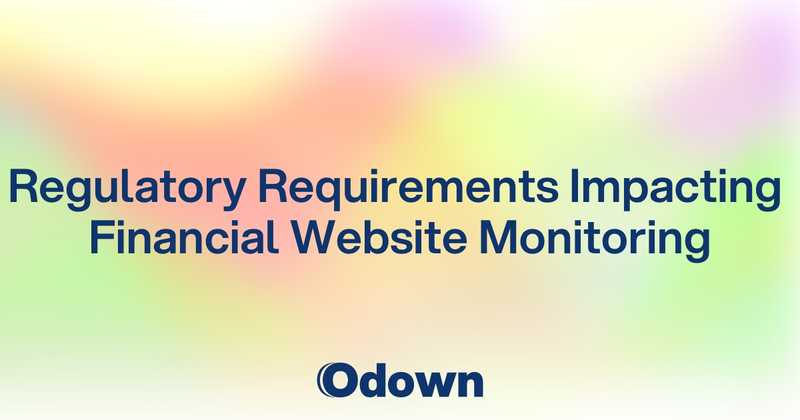Financial Services Website Monitoring
In today's digital-first banking environment, financial institutions face unique challenges in maintaining website reliability, security, and regulatory compliance. While robust security monitoring is essential for all online businesses, financial services organizations must implement specialized monitoring solutions that address both operational reliability and strict regulatory requirements.
Regulatory Requirements Impacting Financial Website Monitoring
Financial services websites operate within a complex regulatory landscape that demands exceptional levels of uptime, performance, and security. Several key regulations directly impact how financial institutions must approach website monitoring:
PCI DSS (Payment Card Industry Data Security Standard) requires continuous monitoring of payment processing systems and mandates regular security testing. Financial institutions must implement robust monitoring to detect unauthorized access attempts and verify that cardholder data remains protected.
SOX (Sarbanes-Oxley Act) necessitates stringent controls over financial reporting systems, including websites that provide financial information to stakeholders. Monitoring must verify data integrity and track all access to financial reporting systems.
GDPR and CCPA impose strict requirements on data protection and privacy. Financial services websites must continuously monitor data access patterns and be able to demonstrate compliance through comprehensive audit trails.
GLBA (Gramm-Leach-Bliley Act) mandates financial institutions safeguard sensitive customer information. Website monitoring must verify that security measures remain effective and that customer data is protected from unauthorized access.
FFIEC Guidelines provide specific recommendations for financial institutions regarding availability, performance monitoring, and incident response capabilities. Monitoring systems must align with these guidelines to demonstrate regulatory compliance.
Implementing a monitoring strategy that addresses these regulatory requirements isn't optional---it's essential for continued operation in the financial sector.
Critical Monitoring Points for Financial Services Sites
Financial websites have several critical components that require specialized monitoring approaches:
Transaction Processing Monitoring
Transaction processing is the lifeblood of financial services websites. Monitoring in this area must:
- Track end-to-end transaction completion rates and processing times
- Verify payment gateway availability and performance
- Monitor third-party payment processor integrations
- Test transaction flows from multiple geographic locations to ensure global availability
- Set up specialized alerts for transaction failure patterns that may indicate systemic issues
For financial institutions, even minor transaction disruptions can have major consequences. Implementing synthetic transaction monitoring that regularly tests complete transaction flows helps identify issues before they impact customers.
Secure Customer Portal Verification
Customer portals represent one of the most sensitive areas of financial websites. Effective monitoring must:
- Verify login functionality works consistently across all supported devices
- Monitor session management to ensure proper timeout functionality
- Test multi-factor authentication processes
- Check account information display accuracy
- Verify secure document upload/download functionality
Monitoring should include regular tests of the entire authentication flow, from initial login through session management to secure logout. This end-to-end testing helps ensure that customer data remains protected while maintaining a seamless user experience.
Audit Trail Documentation
Comprehensive audit trails are essential for both security and regulatory compliance. Your monitoring solution should:
- Log all monitoring activities with accurate timestamps
- Document alert resolution steps and outcomes
- Maintain historical performance data for compliance reporting
- Generate automated compliance reports for auditors
- Preserve evidence of monitoring effectiveness
These audit trails serve dual purposes: they demonstrate regulatory compliance during examinations and provide valuable forensic information during security investigations.
Building Compliant Alerting and Reporting Systems
Financial services websites require alerting and reporting systems that balance operational needs with compliance requirements:
Tiered Alerting Systems should categorize alerts based on regulatory impact. Critical alerts that may affect compliance should trigger immediate notification to compliance officers and IT security teams, while routine performance issues may follow standard escalation procedures.
Customized Alert Thresholds for financial services should be more conservative than general industry standards. For example, while a 99.9% uptime target may be acceptable for many businesses, financial institutions often require 99.99% or higher availability to meet customer expectations and regulatory requirements.
Compliance-Oriented Reporting should automatically generate documentation that aligns with regulatory examination requirements. These reports should demonstrate:
- Consistent monitoring coverage
- Timely resolution of identified issues
- Appropriate escalation of security concerns
- Regular testing of recovery procedures
- Historical performance tracking
Incident Response Integration ensures that alerts trigger appropriate actions from both IT operations and compliance teams. The monitoring system should maintain a closed-loop process that tracks issues from detection through resolution and documentation.
Board-Level Reporting must present website reliability and security metrics in business terms that executive leadership and boards of directors can understand. These reports should clearly connect technical metrics to business risk and regulatory compliance.
Implementing Financial-Grade Monitoring with Odown
Financial services organizations can leverage Odown's comprehensive monitoring platform to meet their specialized requirements:
- Global Monitoring Network: Test financial transactions from multiple geographic locations to ensure consistent performance for all customers.
- Advanced Authentication Testing: Verify secure login processes and session management with specialized monitoring scripts.
- Customizable Alerting: Configure alert thresholds and notification workflows that align with compliance requirements and escalation procedures.
- Comprehensive Reporting: Generate compliance-ready reports that document monitoring coverage, issue resolution, and historical performance.
- Status Page Integration: Maintain transparent communication with customers during incidents while controlling the narrative around service disruptions.
- Incident Management Tools: Document issue investigation and resolution steps to satisfy regulatory requirements for incident handling.
By implementing a monitoring solution tailored to the unique demands of financial services, organizations can satisfy regulatory requirements while ensuring a reliable experience for customers. In today's competitive financial marketplace, robust website monitoring isn't just about maintaining uptime---it's about building customer trust through consistent performance and demonstrable security.



